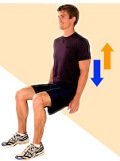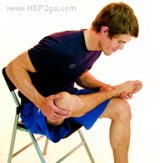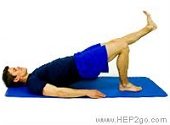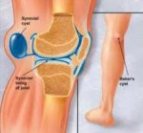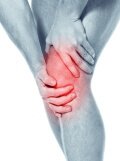Those experiencing upper back pain can benefit from similar exercises. Start by standing facing a large empty wall. Your feet should be a shoulder width apart:
- Place your hands flat against the wall slightly above your head. Lean forward towards the wall until you feel a stretch in your upper back and hold the position for ten seconds. Push your hands into the wall and return to the original position.
- Turn around so that your back is against the wall. Without raising your chin, bring your head back to touch the wall. Hold this position for ten seconds before relaxing into starting position.
- Slide down the wall so that you are sitting with your back against the wall and your feet stretched out in front of you. Your elbows and wrists should be by your side, also against the wall. Slowly slide your arms up the wall until they are above your head. Hold the stretch for ten seconds, and then slide your arms back to the original position by your side.
- Repeat the exercises
Lie on your stomach on a firm surface:
- Place a small towel or cushion under your chest. Stretch your arms out to the side with your thumbs facing the ceiling. Slowly raise your arms towards the ceiling, so that your shoulder blades are squeezed together. Hold this for ten seconds, then slowly bring your arms back to the floor.
- Move the towel or cushion so that it is now under your forehead. Lie with your hands by your sides and your palms on the floor. Lift your hands slightly off the floor and turn your shoulders in so that your palms are facing out and your thumbs are up. Continue to look at the floor but raise your head slightly off the ground. Hold the position for ten seconds, then relax.
- Repeat the exercise several times, and once you are comfortable with it, increase the duration that you hold the positions.
Exercises for Knee Pain
Do exercises for knee pain really make a difference – the answer is a resounding yes! There are a huge number of different causes of knee pain, but in virtually every case exercises will really help to decrease pain and make everyday activities easier.
Improving the strength and flexibility of the leg muscles, changes the support around the knee and how the forces travel through the joint. Better support and better weight distribution helps to reduce pain and improve function.
In this section, you will find a whole range of tailored programmes for all causes of knee problems, as well as loads of great advice on how to exercise safely and my top tips on getting the best results.
There is something here for everyone. We will also look more at how exercises for knee pain help and why people should do them, rather than relying on medications. It is easy to get disheartened when you have pain and to think that it's never going to get better, but that is very rarely true. So take control of things today and get back to doing what you love.
What Exercises are Right for You?
Here you can choose from programmes that have been devised to help the most common causes of knee problems. These exercises for knee pain come with easy to follow instructions including videos and pictures so you know you are doing them correctly. You can choose from general rehab programmes, stretches, strengthening exercises or tailored programmes for specific knee conditions.
If you don’t know where to start, I suggest trying the beginners set first and progress on from there.
Strengthening exercises for knee pain are an essential part of rehab for almost every single knee problem. Muscles start losing their strength really quickly after an injury or episode of knee pain which frequently exacerbates the problem and lengthens the recovery period.
Unfortunately, it takes much longer to increase muscle strength than it does to lose it. That means it is really important to start strengthening exercises for knee pain as soon as possible. Even if your knee is feeling sore, there are some really simple strengthening exercises you can do without having to move the knee that can make a big difference to recovery.
Here you will find graded strengthening programmes to work through. Each set targets the different sets of leg muscles that control the knee - the quads, hamstrings, glutes, calves and kneecap muscles. There is:
1) Beginners Strengthening Programme: This is the place to start. Simple but effective exercises to get those muscles going without any risk of overworking or damaging the knee
2) Intermediate Strengthening Programme: Once you have started to regain some strength and confidence, you can progress on to the next stage to further strengthen the muscles. These can all be done in your own home without any need for specialist equipment
3) Advanced Strengthening Programme: This is the final piece of the puzzle. It will enable you to regain full strength and function so you can return to your usual activities as well as prevent the original problem from flaring up again
4) Knee Cap Strengthening: These exercises target the small muscles around the kneecap, called the VMO. They are vital for controlling the movement of the patella. Weakness in these muscles is a common cause of anterior knee pain
5) Hamstring Strengthening Exercises: These exercises specifically target the hamstring muscles on the back of the thigh, which are often overlooked. They not only improve strength and endurance but can reduce the risk of injury
Tight muscles are a common cause of leg pain. When there is tightness, it increases the tension on the knee, affects how it moves and how forces go through the joint.
Stretching exercises for knee pain can make a big difference. In the knee stretches section, you can find out the best way to stretch safely and effectively - how to get the maximum benefit for the minimum effort! You will also find simple tests that you can do at home to see if your muscles are indeed tight.
Alternatively, if you know what muscle group you want to stretch, go directly to stretches for that specific group:
1) Quads Stretches: for the muscles on the front of the thigh
2) Hamstring Stretches: for the muscles on the back of the thigh
3) Glutes Stretches: for the buttock muscles
4) Iliotibial Band (ITB) Stretches: for the band on the outer thigh
5) Calf Stretches: for the muscles on the back of the leg below the knee
This is a great place to start whether you are recovering from an injury or surgery or have been getting niggles of pain and weakness.
You will find three different programmes of exercises for knee pain each incorporating strengthening and stretching for each group of knee muscles as well as, balance and control work. They are suitable for most knee problems.
You can start with the beginners programme and then once you are happy with those, progress on to the intermediate level and finally the advanced programme. There are easy to follow instructions with videos and photos to help you get the most from these exercises for knee pain.
Exercises for Specific Conditions
Here you can choose from specific programmes for the following conditions:
Arthritis: Wear and tear of the knee joint and cartilage
Bakers Cyst: Inflammation of the popliteal bursa behind the knee
Housemaids Knee: Inflammation of the prepatellar bursa in front of the kneecap
Meniscus Tears: Damage to the special cartilage lining the joint and
Osgood Schlatters Disease: damage to the bone just below the kneecap usually after a rapid growth spurt
Knee Replacements: Exercises to do before and after surgery to improve recovery
ACL Reconstruction Rehab: Exercise program following ACL reconstruction surgery
If your problem is not listed here, don't worry. It just means that the general programmes of exercises for knee pain above should be suitable for you.
One of the most important things when treating pain is to know what is causing the problem so it is really important to see your doctor for an accurate diagnosis. Then you can start on a tailored rehab programme specific to your condition. If you are unsure what is causing your pain, visit the knee pain diagnosis section.
How Do Exercises For Knee Pain Help?
Exercises for knee pain can help to prevent injuries and speed up recovery. To work properly, the leg needs three things, strength (power and endurance), movement (joint range and muscle length) and stability (control, balance and proprioception). Lack of any of them can cause problems and pain.
Any knee injury/problem will almost certainly affect the leg muscles. The main problems that develop are:
1) Tightness: which limits how much the leg can move and
2) Weakness: which limits either the instantaneous strength of the muscle or the endurance (how long the muscle can work for)
Tightness and weakness leads to muscle imbalance where some muscles don’t work hard enough and others try to work extra hard to compensate. When this happens, subtle changes take place in the way force and weight goes through the joint, meaning that:
1) More weight goes through certain parts of the knee than should do
2) The knee moves in a way it is not designed to putting more pressure on the ligaments and cartilage
The result of both of these is pain, and an increased risk of injury. Exercises for knee pain help to combat that. All of these knee rehab plans are designed to increase the strength and flexibility of your muscles and to improve balance and proprioception. This will help:
1) Reduce pain and swelling
2) Ensure a full recovery from an injury
3) Prevent knee problems developing or recurring
Getting The Best Results
When doing exercises for knee pain, it is vital that you are working at the right level for your problem. If you overwork an injured knee, you could cause more damage. But if you don’t work it hard enough, you won’t build up much strength or mobility. See the exercise overview for guidance on how hard to push yourself.
I find one of the biggest barriers to regularly doing exercises for knee pain is motivation. People usually start with great intentions but after a few weeks, they get a bit bored, and stop, particularly if the pain has started to improve. Visit the Getting the Best Results section for my top tips on how to stay motivated, how to progress your exercises for knee pain and how to ensure success! It usually takes a good few weeks to notice much change as muscles gain strength much more slowly than they lose it unfortunately. Perseverance is key!
KNEE CARE
Obesity is the number one preventable risk factor for osteoarthritis of the knee. Excess weight strains the knees, causing cartilage to wear away. In addition, fat cells are believed to produce inflammatory cytokines that contribute to arthritis. If you are overweight, even modest weight loss can reduce the risk of osteoarthritis and its progression. Weight loss will also reduce some of the stress of the knee, which can be helpful, regardless of the problem.
The Neck Pain Exercises
Neck pain exercises lying down: Lay down and rest your head on a comfortable pillow with your knees bent and feet on the floor.
1) The chin nodding neck pain exercises:
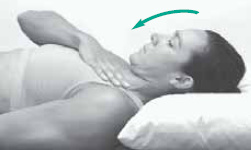 |
 |
|
Slowly and gently perform a nodding motion with your head like you are motioning “yes”. With your hand, check the front muscles and stop the nodding motion when you feel these muscles begin to contract.
|
Hold the nodding position for about 5 seconds, then relax by gently moving your head to the starting position. You may do 10 repetitions.
|
You should note this is the first of the neck pain exercises for a reason. This motion is very important in restoring control of deeper muscles that is often lost with poor posture, whiplash injury and chronic neck pain. This can be done in a sitting or standing position and is great for taking short breaks if you do computer work. This part of the exercises may have an immediate effect in reducing neck pain. It requires some time to practice and learn the correct motion. Please take a short time to review a more detailed view using the correct motion for this neck exercise.
2) Head rotation neck pain exercises:
 |
 |
|
Carefully rotate by turning your head from one side to the other. Be sure to look in the direction your turning. Try each time to gradually turn your head so that your chin lines up with the shoulders, viewing the wall in line with your shoulders. You can do 10 repetitions to each side.
|
3) Shoulder blade exercises:
|
These exercises help relaxation and easing of tension in the top portion of the shoulder muscles.
|
 |
 |
|
Lay on your right side, arm resting up comfortably on pillows.
|
Retract the left shoulder blade back and across your chest to the middle of your back using a rollin motion. Hold for 10 seconds. Do 5 repetitions.
|
|
Repeat this while lying on your left side for the right shoulder blade.
|
Neck pain exercises while sitting:
4) Posture position exercise:
 |
Make corrections to your posture by gently straightening your low back and pelvis. Carefully pull the shoulder blades backward and downward. Softly tuck your chin inward. Hold this posture gently for 10 seconds.
This position helps prevent and eases muscle pain and tension in the neck and shoulder muscles. Repeat this maneuver on a regular basis – about every half hour during the day if possible. These exercises can be done at work, in a vehicle and just sitting at home.
|
5) Neck retraction exercises:
|
Sit in a good posture as shown in # 4.
|
 |
 |
|
Softly pull the head backward while moving your chin straight back in a sliding motion, making sure to keep your nose pointed straight forward. You should be able to feel this motion in the base of the neck as your neck positions upward and elongated. Do 10 repetitions every hour while you sit.
|
Neck motion exercises: Make sure you are sitting in the postural position described in exercise # 4. For the exercises below, do 10 repetitions each side.
6) Rotation neck pain exercises:
 |
 |
|
Softly rotate the head from one side to the other, looking at the direction you are turning to, gradually progressing to see the wall line up with your shoulders. This is a similar exercise to the one in the lying down position. Your neck should stay elongated. Do 10 repetitions every hour when seated.
|
7) Side bending neck pain exercises:
 |
 |
|
Carefully bend your head to your shoulder, feeling a gentle stretch in the side muscles of your neck. Performing to each side.
|
8) Bending and extension neck pain exercises:
 |
 |
|
Slowly bend your head to your chest, leading the movement with your chin. Move the chin first, bringing the head back to the upright position, then gently rolling it backward, looking upward to the ceiling. Again, lead with your chin and return the head to an upright position.
|
Neck strengthening exercises: (Exercises 9-11) should only be done later in recovery. If you are unsure when to start these, ask your health care professional.
9) Neck strengthening exercises (isometric, no movement exercise):
 |
 |
|
Again, sitting in correct posture, make sure your chin relaxes and points slightly downward. Put your right hand on your right cheek area and slowly turn your head into your hand as you look over your right shoulder, however, no motion should take place. Hold this mild contraction of the muscles for five seconds only using about 10 to 20% of your strength. Repeat this using your left hand on the left cheek area. Do 5 repetitions to each side.
|
Neck strengthening exercises with 4-point kneeling:
 |
|
Assume a 4 point position while kneeling. Start by making sure your knees are placed under your hips with the hands under the shoulders. Your lower back must be relaxed in a naturally formed arch. Carefully pull your stomach area to your spine using only 10% strength. Push gently through the shoulder blades so your upper back is level. Pull the shoulders gently away from your ears, toward your hips. Lift your head up level with your shoulders, keeping a gently tucked chin or nodding position. When you are capable of holding the 4 point kneeling posture, proceed with the neck motion exercises below:
|
10) Neck bending and extension exercises in 4-point kneeling:
 |
 |
|
Assume the safe 4 point kneeling position and carefully look up toward the ceiling as much as possible. Hold this for 5 to 10 seconds, then slowly bend your neck with the chin nodding action. Continue with the neck bending motion as far as you can go comfortably, trying to touch your chin to your chest. Keep holding the relaxed low back and shoulder blade position detailed above. Do 5 to 10 repetitions.
|
11) Neck rotation exercises in 4-point kneeling:
 |
|
Assuming the 4 point kneeling position, slowly turn your neck to one side while maintaining a gentle chin nodding position. Make sure the head remains level with your body, not allowing it to fall down. Doing this exercise correctly, you will be looking over your shoulder at the end of the motion. You may do this part of the neck pain exercises with a mirror so check your head position. Repeat to the other side. Do 5 to 10 repetitions.
|
WAYS TO PREVENT ANKLE PAIN
Many ankle injuries can be treated simply at home with over the counter (OTC) nonsteroidal anti-inflammatory drugs (NSAIDs) such as ibuprofen (Advil, Motrin IB) and naproxen (Aleve). If you cannot tolerate NSAIDs or you are already taking anti-inflammatories for arthritis, however, contact your doctor before taking an OTC pain-reliever.
Within 48 hours of the injury, you should also begin self-care measures. Use the acronym RICE to help remember these treatments:
- Rest. Take a break from activity. Avoid walking on your injured ankle.
- Ice. Place an ice pack on your ankle for 15 to 20 minutes at a time to reduce pain and swelling.
- Compression. Wrap a compression bandage around the ankle to reduce swelling.
- Elevation. As much as possible, keep your foot elevated to reduce swelling. Use a stool when sitting at your desk or place your foot on pillows when relaxing on the couch.
Whether you have an acute injury or chronic arthritis, medications don't always relieve pain completely. And if you have surgery, you'll likely need some help getting around while you heal. At times when you need extra help with pain relief or mobility, here are some techniques and devices worth trying.
Hot and cold. While cold is helpful for reducing inflammation from a new ankle injury, it also can be helpful for chronic pain or for the pain and inflammation of an arthritis flare. For aching ankles without acute inflammation, heat may provide relief.
Canes. If placing weight on your ankle causes pain, your doctor or physical therapist may recommend a cane. There are many different types of canes. The most common type has a single tip, but if you have trouble balancing, your doctor may recommend a quad, or four-point cane. Your doctor can advise the best way to use your cane, but generally you should hold it in the hand opposite the painful ankle.
Ankle Braces. Ankles braces can support the ankle during recovery from an injury or surgery or help reduce the risk of re-spraining a sprained ankle. Braces fall into two basic categories – rigid and functional. Rigid braces immobilize the entire ankle, while functional braces allow some movement. There are many variations on each of the different types.
Electrical Stimulation. Electrical stimulation of muscle tissue (called neuromuscular electrical stimulation) around the ankle may be useful for strengthening the muscles that support the joint and relieving pain in and around the joint. A number of studies have shown the treatment to be effective, however, studies have focused specifically on the treatment for knee osteoarthritis.
Weight Loss. Because the ankles bear the weight of the body, excess body weight can put more stress on ankles, leading to or worsening ankle pain. Weight loss, in turn, may help reduce ankle pain.
HIP CARE
Medications and injections don't always completely relieve hip pain. And if you have surgery, you'll likely need some help getting around while you heal. At times when you need extra help with pain relief or mobility, here are some techniques and devices worth trying.
• Canes. If placing weight on your hip causes pain, your doctor or physical therapist may recommend a cane. There are many different types of canes. The most common type has a single tip, but if you have trouble balancing, your doctor may recommend a quad, or four-point cane. Your doctor or physical therapist can advise the best way to use your cane, but generally you should hold it in the hand opposite the painful hip.
• Electrical Stimulation. Electrical stimulation of muscle tissue (called neuromuscular electrical stimulation) around the hip may be useful for strengthening the muscles that support the joint. Electrical stimulation may also increase blood flow to the tissues around the hip joint to relieve pain and promote the healing of injuries.
• Ultrasound. Ultrasound uses high frequency sound waves to stimulate the deep tissues within the body. It is believed that vibration of the sound waves stimulates deep tissues, to relieve pain, increase blood flow and, thereby, possibly promote healing.
• Cold and Heat. Warming tissues eases arthritis pain by increasing blood flow to affected areas, which can help decrease inflammation, relax tight muscles and eliminate waste products, such as lactic acid, that cause stiffness and soreness. Cold therapy, applied in the form of cold packs, ice packs, or fluids work by decreasing blood flow to reduce swelling, slowing the transmission of pain signals through nerves and inhibiting inflammatory chemicals. Cold application is also helpful to reduce pain, swelling and inflammation after an injury.
While you can't prevent all hip problems, many of the same measures used to treat hip problems can reduce your risk or help prevent them from getting worse. Losing weight for example, may help keep hip osteoarthritis from progressing and proper exercise may help reduce pain and injury risk.
Taking measures to prevent injuries and tending to them promptly when they happen can prevent problems both now and down the road.
The following tips can help:
• Stretch and warm up before exercise. Cool down afterward.
• Don't overdo it. If you experience pain when exercising, stop and cool down.
• Wear properly fitting shoes.
• Avoid running on hard surfaces like asphalt and concrete when possible.
If you experience an injury to your hip, rest, elevate it and apply ice. If pain is severe or persists more than a day or two, call your doctor.
Maintaining a healthy weight – or losing weight if you are overweight – is good for your joints. Excess weight stresses the weight-bearing joints, such as the hip and knee, contributing to cartilage damage. In addition, fat cells are believed to produce inflammatory cytokines that contribute to arthritis.



















